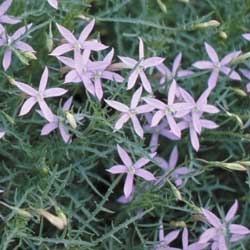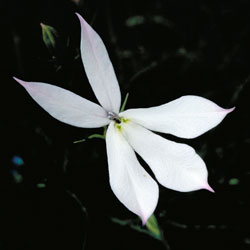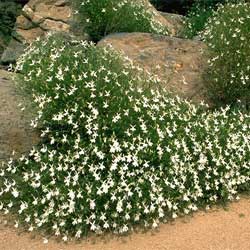Isotoma axillaris
Isotoma anethifolia
Australian Harebell, Showy Isotome (I. axillaris only)
Isotoma axillaris Lindl.
Isotoma anethifolia Summerh.
Isotoma axillaris and Isotoma anethifolia are profusely flowering perennial herbs that grow up to 40cm high. Although sometimes included in Campanulaceae, Isotoma are generally recognised as members of the Lobeliaceae family. The acrid milky sap of Isotoma axillaris and Isotoma anethifolia is a common characteristic in this family. It can cause severe irritation to skin and temporary blindness if inadvertent contact is made with eyes, and has been reported to be poisonous to stock.
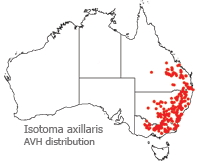 |
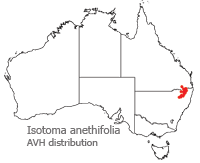 |
Isotoma axillaris is widespread from Victoria through New South Wales and Southern Queensland. It grows in damp crevices or shallow soil in rocky areas. Isotoma anethifolia naturally occurs on the Northern Tablelands and Northwest Slopes of New South Wales as well as parts of Queensland. It grows in damp crevices on rocky cliffs, especially granite and sandstone, or shallow sandy soils. They are both particularly suitable for planting in rockeries, containers and native cottage gardens.
Isotoma axillaris and Isotoma anethifolia are easily propagated and require minimal maintenance, yet flower profusely and for many months. They thrive in well-drained, humus-enriched soil or rocky crevices and full sun, but will tolerate dappled shade.
Isotoma axillaris and Isotoma anethifolia can be easily propagated from seed. Seed can be scattered directly in late winter, when there is no more danger of frost, or planted into pots and then transplanting in spring. Plants will require regular watering until established, and then only need watering about once a week, perhaps more in the heat. Propagation from firm cuttings is also possible, but it is recommended that gloves be worn to avoid reactions to the sap.
These warnings about the sap should not deter gardeners from planting these species as long as appropriate precautions are taken, as they give lasting flower displays in return for very little work. Also, the sap seems to be equally distasteful to potential herbivores. The plantings in the Australian National Botanic Gardens show no evidence of herbivory by either marsupials or insects.
Both species can flower as early as October, right through to May with Isotoma axillaris producing blue to mauve flowers while Isotoma anethifolia flowers are white. The foliage will then die off and should be cut back to encourage fresh new growth. They are somewhat frost sensitive, but can be treated as annuals in cold climates. Isotoma axillaris appears to be more tolerant of colder climates than Isotoma anethifolia. Although not essential, liquid fertiliser can be applied to encourage more abundant flowering.
Isotoma axillaris and Isotoma anethifolia are particularly attractive when planted together. A mixture of the two seeds can simply be scattered together for an attractive mix of blue and white flowers.
Text by Alice Blackwood (2008 Student Botanical Intern)
Name Meanings: Isotoma spp.Isotoma: from iso, meaning equal, and toma, meaning a section, referring to the equal lengths of the corolla segments, helping to distinguish Isotoma from the genus Lobelia. axillaris: borne in the axil, referring to the position of the flowers in the axils of leaves. anethifolia : from anethum, the genus of the well known culinary herb dill, and folium (a leaf), referring to leaves shaped like those of dill. |
References
Corrick, M.G. & B.A.Fuhrer (2009) Wildflowers of Southern Western Australia, 3rd edn. Rosenberg Publishing Pty Ltd, Dural, NSW.
Elliot, W. & Jones, D. (1990) Encyclopaedia of Australian Plants for Cultivation. Lothian Publishing, Melbourne.
Hurle, P. (2008) Horticultural Manager, ANBG. Personal communication.
Stearn, W. T. (1992) Stearn’s Dictionary of Plant Names for Gardeners. Cassell, London.
![An Australian Government Initiative [logo]](/images/austgovt_brown_90px.gif)


